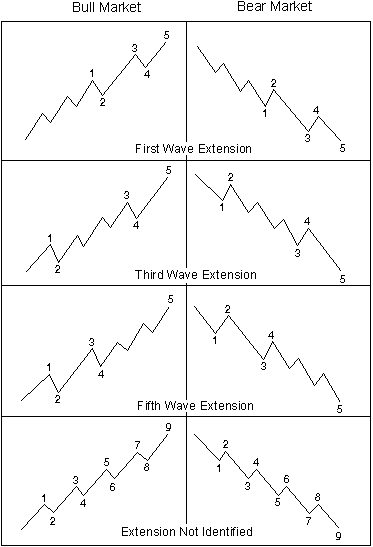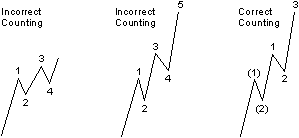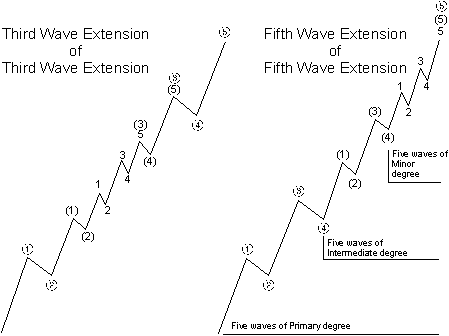Extension
Key Takeaway: Most impulses contain an extension. Extensions are elongated impulses with exaggerated subdivisions. It’s good to be on the right side of an extended wave.
Most impulses contain what Elliott called an extension. An extension is an elongated impulse with exaggerated subdivisions. The vast majority of impulses contain an extension in one and only one of their three actionary subwaves. The rest either contain no extension or an extension in both subwaves three and five. At times, the subdivisions of an extended wave are nearly the same amplitude and duration as the other four waves of the larger impulse, giving a total count of nine waves of similar size rather than the normal count of “five” for the sequence. In a nine-wave sequence, it is occasionally difficult to say which wave extended. However, it is usually irrelevant anyway, since under the Elliott system, a count of nine and a count of five have the same technical significance. The diagrams in Figure 1, illustrating extensions, will clarify this point.

The fact that an extension typically occurs in only one actionary subwave provides a useful guide to the expected lengths of upcoming waves. For instance, if the first and third waves are of about equal length, the fifth wave will likely be a protracted surge. Conversely, if wave three extends, the fifth should be simply constructed and resemble wave one.
In the stock market, the most commonly extended wave is wave 3. This fact is of particular importance to real-time wave interpretation when considered in conjunction with two of the rules of impulse waves: Wave 3 is never the shortest actionary wave, and wave 4 may not overlap wave 1. To clarify, let us assume two situations involving an improper middle wave, as illustrated in Figures 2 and 3.

In Figure 2, wave 4 overlaps the top of wave 1. In Figure 3, wave 3 is shorter than wave 1 and shorter than wave 5. According to the rules, neither is an acceptable labeling. Once the apparent wave 3 is proved unacceptable, it must be relabeled in some way that is acceptable. In fact, it is almost always to be labeled as shown in Figure 4, implying an extended wave (3) in the making. Do not hesitate to get into the habit of labeling the early stages of a third wave extension. The exercise will prove highly rewarding. Figure 4 is perhaps the single most useful guide to real time impulse wave counting in this waveopedia.
Extensions may also occur within extensions. In the stock market, the third wave of an extended third wave is typically an extension as well, producing a profile such as shown in Figure 5. Figure 6 illustrates a fifth wave extension of a fifth wave extension. Extended fifths are quite common in major bull markets in commodities.

“So wait… I can really learn to predict the markets?”

Yes. Markets aren’t rational. For every action, there isn’t always an equal and opposite reaction.
What drives prices isn’t logic, but emotion. Market emotions unfold in predictable patterns called Elliott waves. That’s what makes prices predictable.
What you just read is from the Wall Street bestseller, “Elliott Wave Principle: Key to Market Behavior.” For 40+ years, it’s been a top-shelf book on unbiased market analysis.
Amazon reviewers call it “classic and essential” and ” the bible of the theory.” Now, you can get instant, FREE access to the full online version of this book ($29 value).